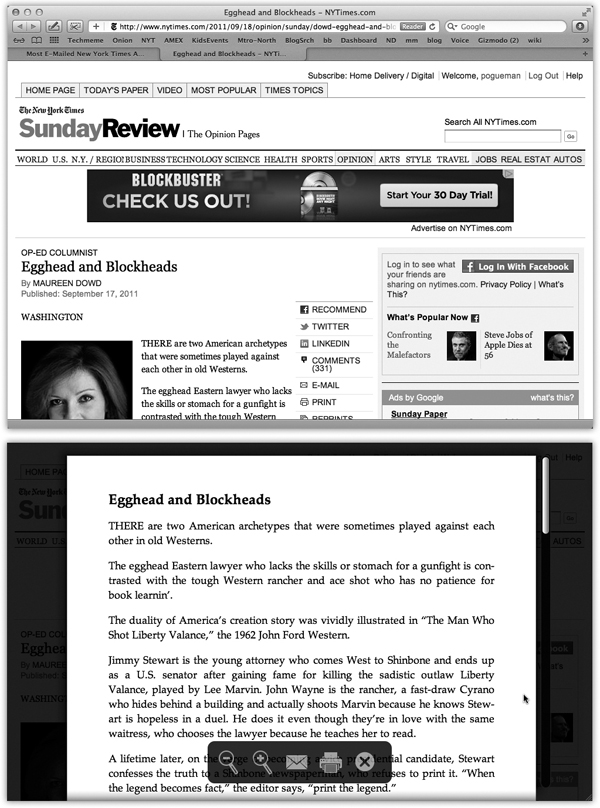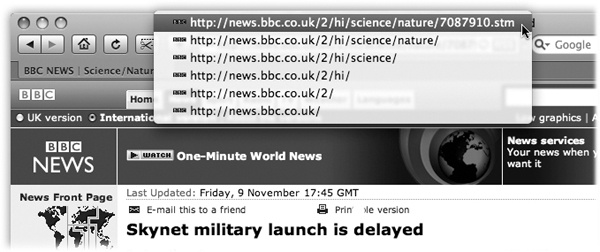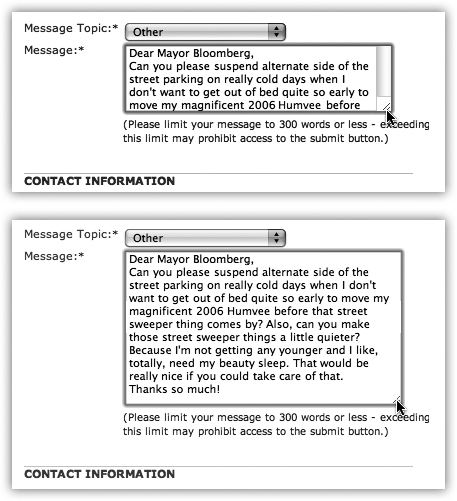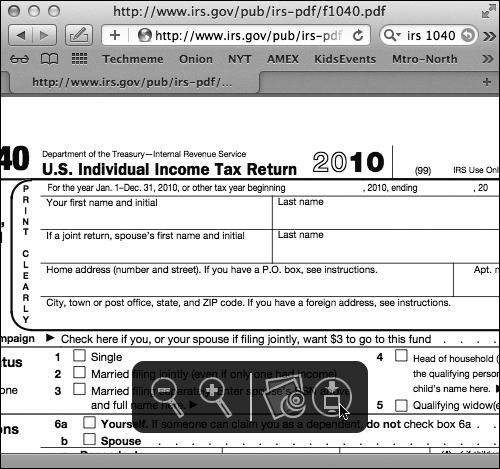Safari is filled with shortcuts and tricks for better speed and more pleasant surfing. For example:
How can people read Web articles when there’s Times-Square blinking going on all around them? Fortunately, you’ll never have to put up with that again.
The Reader button in the address bar is amazing. With one
click (or press Shift-![]() -R), it eliminates
everything from the Web page you’re reading
except the text and photos. No ads, blinking, links, banners,
promos, or anything else.
-R), it eliminates
everything from the Web page you’re reading
except the text and photos. No ads, blinking, links, banners,
promos, or anything else.
The text is also changed to a clean, clear font and size, and the background is made plain white. Basically, it makes any Web page look like a printed book page or a Kindle page, and it’s glorious (Figure 12-5).
To exit Reader, press the same keyboard shortcut, or click the Reader button again.
Best. Feature. Ever.
The Reading List is a hide-able panel at the left side of the screen that lists Web pages you want to read later (Figure 12-6).
The Reading List doesn’t actually store the pages on the Mac; it basically stores a link to the page, just like a bookmark. You can’t read it later unless you’re actually online.
It does have some advantages over bookmarks, though. For example, it’s faster to flag a Web page you like—you don’t have to make up a name or location for it, as with a bookmark. The Reading List keeps track of what you’ve read; you can use the All/Unread buttons at the top of the list to view everything, or just what you haven’t yet read. You might treat the Reading List as a list of pages you’ll want to read once later, and use bookmarks for pages you like to revisit frequently.
Tip
To make matters even sweeter, iCloud synchronizes your Reading List among your Mac, iPhone, iPad, and so on—as long as you’ve turned on bookmark syncing. It’s as though the Web always keeps your place.
To add a page to the Reading List, use one of these techniques:
Shift-click a link. That simple trick adds the linked page to the Reading List. You haven’t even had to visit the page itself (only the link to it), or even to open the Reading List itself.
Figure 12-5. Seriously, which way would you rather read an article? Like this (top)? Or in the calm peace of this (bottom)? Not only does Reader get rid of all the ads and clutter and blinking, it even knits together multipage articles into one seamless scrolling page. Use the space bar or two fingers to scroll, as usual. Point near the bottom of the page to produce a palette of useful buttons, like Zoom out, Zoom in, “Mail this page,” “Print this page,” and “Hide Reader.”
Use the menu. If you’re already on the page you might want to read later, choose Bookmarks→Add to Reading List, or press Shift-
 -D.
-D.Use the Reading List. If the Reading List is already open, just click Add Page to add the current page to the list.
Once you’ve added a page to the Reading List, you can get to
it by clicking the ![]() button on the toolbar, or by choosing
View→Show Reading List, or by pressing Shift-
button on the toolbar, or by choosing
View→Show Reading List, or by pressing Shift-![]() -L.
-L.
To read the pages you’ve flagged for the Reading List, you can
press Option-![]() -↓ or Option-
-↓ or Option-![]() -↑ to move up and down your list.
-↑ to move up and down your list.
If any app is going to remind you of an iPhone/iPad,
it’s Safari. Once you enter full-screen mode by clicking the
![]() button at upper right (see Full Screen Mode, Safari), it’s almost exactly like
surfing the Web on the iPad. For example:
button at upper right (see Full Screen Mode, Safari), it’s almost exactly like
surfing the Web on the iPad. For example:
Zoom in and out with pinch and spread. That is, put two fingers on your trackpad and spread them to magnify the Web page, or pinch to zoom out. Great when the type is a little too small.
Magnify just a block with a two-finger double-tap. Most Web pages are subdivided into various rectangles of text or graphics. Just as on the iPhone/iPad, you can double-tap (with two fingers on your trackpad) to magnify only one single block of text or graphics. Repeat the process to zoom back out to regular size. (Note that this is tapping, not clicking.)
Use a two-finger swipe for Back and Next. This one’s really juicy. With two fingers on your trackpad, swipe left or right instead of clicking the ◂ or ▸ buttons. The great part is that if you do this slowly, you pull the previous or next page onto the screen gradually, giving you a chance to peek at the page without actually moving to it.
Figure 12-7. Click the Downloads (![]() ) button to view this list of recent
downloads. Double-click an icon to open the download. Click the
) button to view this list of recent
downloads. Double-click an icon to open the download. Click the
![]() button to jump to the file wherever it’s
sitting in the Finder. To remove an item from the list, click it
and then press Delete. (The Clear button erases the whole list.)
You can also drag an item out of this list and onto the desktop to
park it there.
button to jump to the file wherever it’s
sitting in the Finder. To remove an item from the list, click it
and then press Delete. (The Clear button erases the whole list.)
You can also drag an item out of this list and onto the desktop to
park it there.
Note
Each time you open Safari, it brings up whatever pages you had open last. That’s part of Lion’s auto-resume feature (Windows that Auto-Reopen).
When you click a link to download something from a Web page,
it visibly flies to the upper-right corner of
the Safari window, where the Downloads button ![]() appears. You can then monitor the progress of
the download at a glance—because the Downloads button
fills up with blue as the download
completes.
appears. You can then monitor the progress of
the download at a glance—because the Downloads button
fills up with blue as the download
completes.
As Figure 12-7 shows, you can also view and manipulate a list of everything you’ve downloaded recently, all without leaving the comfort of whatever page you’re on.
To pause downloading, click the ![]() button next to the download’s name. Later,
you can generally pick up from where you left off by clicking the
Resume (
button next to the download’s name. Later,
you can generally pick up from where you left off by clicking the
Resume (![]() ) button.
) button.
When you see a picture you’d like to keep, right-click it and choose Save Image to Downloads (or Add Image to iPhoto Library, or just Save Image As) from the shortcut menu. Safari stores it as a new graphics file, freed from its birthplace on the Web. (You can specify where Safari saves downloaded pictures on the Safari→Preferences→General tab. In that case, the shortcut menu’s wording changes to say, for example, “Save Image to ‘Pictures.’”)
The little orange SnapBack button (![]() ), which sometimes appears at the right end of
the address bar or search box, takes you instantly back to your last
page of search results.
), which sometimes appears at the right end of
the address bar or search box, takes you instantly back to your last
page of search results.
The point here is that, after burrowing from one link to another in pursuit of some Google result or Amazon listing, you can return to your starting point without having to mash the Back button over and over again. (The SnapBack button doesn’t appear until you’ve actually clicked away from the first page you visited.)
The world’s smarmiest advertisers inundate us with pop-up and pop-under ads—nasty little windows that appear in front of the browser window or, worse, behind it, waiting to jump out the moment you close your current window. They’re often deceptive, masquerading as error messages or dialog boxes, and they’ll do absolutely anything to get you to click inside them.
If this kind of thing is driving you crazy, choose Safari→Block Pop-Up Windows, so that a checkmark appears next to the command. It’s a war out there—but at least you now have some ammunition.
Note
This feature doesn’t squelch small windows that pop up when you click a link—only windows that appear unbidden.
Even unbidden windows, however, are sometimes legitimate (and not ads)—notices of new banking features, warnings that the instructions to use a site have changed, and so on. Safari can’t tell these from ads and stifles them, too. So if a site you trust says, “Please turn off pop-up blockers and reload this page,” then you know you’re probably missing out on a useful pop-up message.
And one more thing: These days, the evildoers of the Internet have begun to attract your attention using other programming tricks that don’t work by creating new windows (instead, they create new layers in your browser window). There’s not much you can do about those nuisances.
If it seems as though a lot of Web sites are designed with type that’s too small to read, it’s not just you and your aging eyes. Often, it has to do with the high resolution of today’s screens, which work by packing their pixels together more tightly—and making everything look smaller.
Fortunately, Safari is extremely well equipped to help you with this problem. In fact, it offers many solutions:
Enlarge the screen. Press
 -plus or
-plus or  -minus to enlarge or reduce the entire
Web page. Or use the two-finger “spread” gesture on your
laptop trackpad. Or use the Zoom button, if you’ve added it to
your toolbar. The advantage of this method is that the whole
Web page’s layout remains proportional.
-minus to enlarge or reduce the entire
Web page. Or use the two-finger “spread” gesture on your
laptop trackpad. Or use the Zoom button, if you’ve added it to
your toolbar. The advantage of this method is that the whole
Web page’s layout remains proportional.Magnify a block. Double-tap (not click) with two fingers on your trackpad to zoom into one block of text or graphics on a page.
Blow up just the text. If you turn on View→Zoom Text Only, then all those shortcuts serve to magnify or shrink only the text on your page. Graphics remain at their original size. You’re now distorting the original layout, but you’re maximizing the amount of reading you can do before you have to scroll.
Zoom in the usual way. You know the Control-key zooming technique described in Zoom? It’s not the same thing as the
 -plus or
-plus or  -minus tricks, which keep the window
frame and menu at normal size. The Control-key zooming
technique magnifies everything—the entire
screen, menus and all. It also doesn’t keep text as sharp as
the
-minus tricks, which keep the window
frame and menu at normal size. The Control-key zooming
technique magnifies everything—the entire
screen, menus and all. It also doesn’t keep text as sharp as
the  -plus/
-plus/ -minus trick.
-minus trick.Specify a minimum type size. This may be the best option of all, because it saves you all that zooming. Open Safari→Preferences→Advanced, and set the “Never use font sizes smaller than” option to, for example, 14 points. Now every Web page shows up with legible text. (Except a few oddballs that use weird coding to prevent text-size changing.)
Efficiency freaks generally prefer keyboard shortcuts to using the mouse, so Safari is filled with them.
Press Tab to jump from one text box or pop-up menu to the next on your Web page. Add the Option key to jump from one link to another (and when you highlight a link, press Return to “click” it).
You don’t have to be connected to the Net to read a favorite Web page. You can save it on your hard drive so you can peruse it later—on your laptop during your commute, for example—just by choosing File→Save As.
At that point, to save the entire page, along with all its images, movies, and so on, choose Web Archive from the Format pop-up menu. (Choose Page Source only if you intend to edit the raw HTML Web documents and then repost them, or if you just want to study the underlying code.)
Tip
When you buy something online, don’t waste paper by printing out the “This is your receipt” page. Instead, choose File→Print and, from the PDF pop-up button, choose Save PDF to Web Receipts Folder. Safari saves the page as a PDF file into a tidy folder (in your Home→Documents folder) called Web Receipts. Nice touch!
Occasionally, you may wish you could view a little map that marks the path of the current Web page within its site. Ah, but Safari has already thought of that. See Figure 12-8.
Safari provides two ways of telling a friend about the page you’re looking at. You might find that useful when you come across a particularly interesting news story, op-ed piece, or burrito recipe.
The send-the-whole-page method. While looking at a page, choose File→Mail Contents of This Page (
 -I) to open a new Mail message with a
copy of the actual Web page in the body.
Address the message and click Send.
-I) to open a new Mail message with a
copy of the actual Web page in the body.
Address the message and click Send.The send-a-link method. To send just a link to the page you’re looking at, choose File→Mail Link to This Page (Shift-
 -I). Then proceed as usual, addressing
the message and clicking Send.
-I). Then proceed as usual, addressing
the message and clicking Send.Links take only a split second for your recipient to download, and they’re guaranteed to display properly in all email programs. All your recipients have to do is click the link to open it in their Web browsers.
If the customer-service comment form on that corporate Web site doesn’t give you enough room to rant properly, you can resize the text box right on the page—a very welcome feature. Figure 12-9 tells all.
Figure 12-9. This trick works on a Web page’s text fields—comment boxes, forms to send a letter to the mayor, and so on. You can resize such boxes by dragging the three diagonal ribbed lines in the lower-right corner of the text field. The rest of the page adjusts itself to the new text-box size, and you have room to say what you need to say.
What’s the first thing you see when you open Safari? Is it the Apple news Web site? Is it the Top Sites display (Figure 12-3)?
Actually, that’s up to you.
Choose Safari→Preferences→General tab. Here, the “New windows open with” pop-up menu offers choices like these:
Top Sites. The thumbnail view of your favorites sites makes a great starting point.
Home Page. If you choose this option, then Safari will open up with whatever page you’ve specified in the “Home page” box. Google—or its news page, http://news.google.com—is a good starting place. So is your favorite newspaper home page, or maybe www.dilbert.com for today’s Dilbert cartoon.
If you’re already on the page you like, just click Set to Current Page.
Empty Page. Some people prefer this setup, which makes Safari load very quickly when you first open it. Once this empty window opens, then you can tell the browser where you want to go today.
Bookmarks. Whenever you open a new window or launch Safari, you see your full list of bookmarks. You can then choose exactly which page you want to open.
Tabs for Bookmarks Bar. This intriguing option creates a row of tabs in a single window—one for every icon on your Bookmarks bar. The idea, of course, is to have not just one favorite Web page waiting for you in the morning, but all the ones you visit frequently, preloaded and ready to go.
Choose Tabs folder. This option is similar to Tabs for Bookmarks Bar, except that it starts you off with tabs for any random bunch of Web sites—not just the ones on your Bookmarks bar. The trick is to build a folder full of bookmarks, and choose that as the basis for your auto-opening tabs.
Some pages are so long, dense, or poorly designed that finding the words on the page needs a whole ’nother search engine. Safari’s search-within-the-page function shines a light on the words or phrase you’re seeking.
To use it, press ![]() -F and then type your search word into the
Find box (Figure 12-10). As Safari
locates the word or words, it displays them within a bright yellow
box and dims the background of the rest of the page. The Find
bar also tells you how many times the word or phrase occurs on the
page; you can jump to each instance. Click the
-F and then type your search word into the
Find box (Figure 12-10). As Safari
locates the word or words, it displays them within a bright yellow
box and dims the background of the rest of the page. The Find
bar also tells you how many times the word or phrase occurs on the
page; you can jump to each instance. Click the ![]() to start over with new search terms, or click
Done to close the Find box and return to your normal browsing
activity.
to start over with new search terms, or click
Done to close the Find box and return to your normal browsing
activity.
The History menu lists the Web sites you’ve visited in the past week or so, neatly organized into subfolders like Earlier Today and Yesterday. (A similar menu appears when you click and hold the ◂ or ▸ button.) These are great features if you can’t recall the URL for a Web site you remember having visited recently.
Tip
See Safari’s Help menu? It features a search box that lets you search all the menu commands in Safari—including Safari’s History menu. That’s just a crazy powerful feature. It means you can re-find a site without having to hunt through all the History submenus manually; just search for a word you remember in the title.
You can also view your History in a more expansive view—in
Cover Flow view, in fact—by clicking the ![]() at the left end of your toolbar. You enter
the Bookmarks-management view, described in Figure 12-4.
at the left end of your toolbar. You enter
the Bookmarks-management view, described in Figure 12-4.
PDF files are all over the Web as, among other things, forms to download, online brochures, and scanned book pages. But they aren’t always especially readable in a browser window.
Unless, that is, you’re using Safari. The next time you’re squinting at a PDF in the window, point to the bottom edge of the document; you’ll see a toolbar like the one in Figure 12-11 appear. With these four icons, you can zoom out, zoom in, open the file in Preview, or save the PDF file to your Downloads folder.







